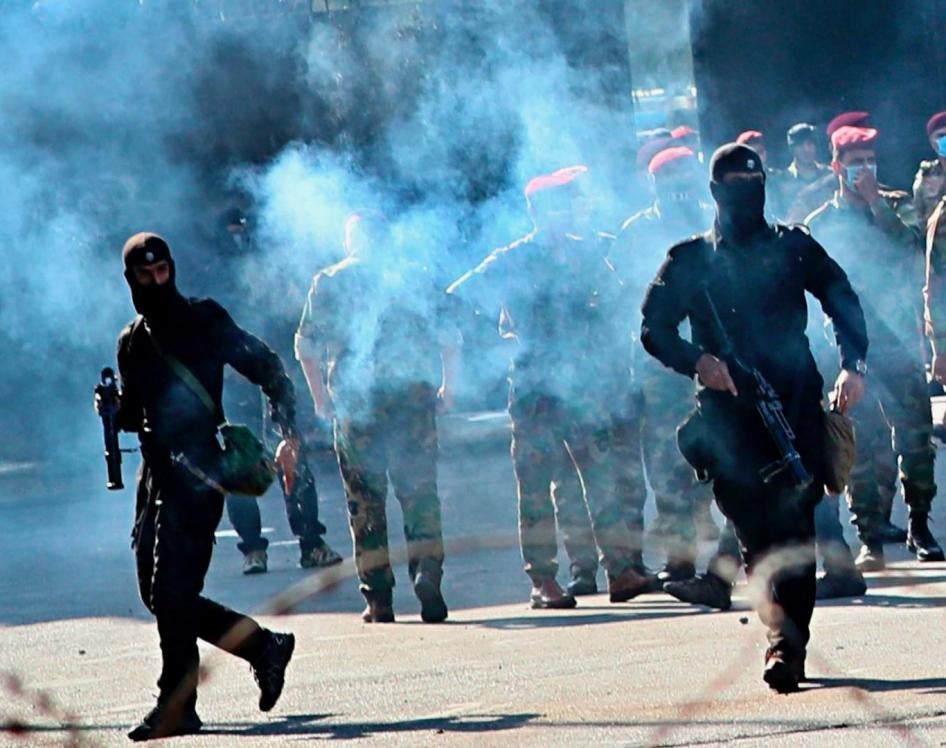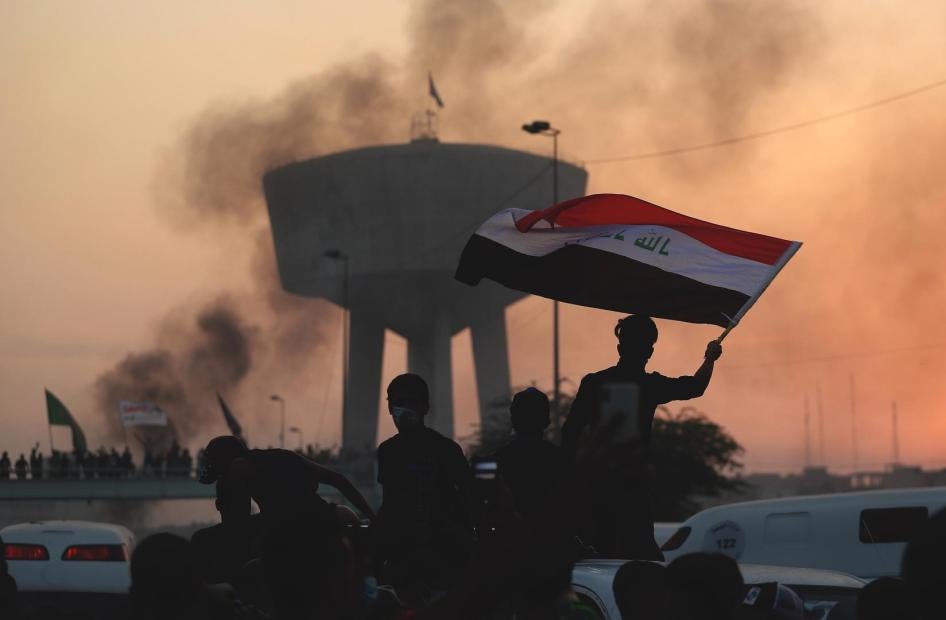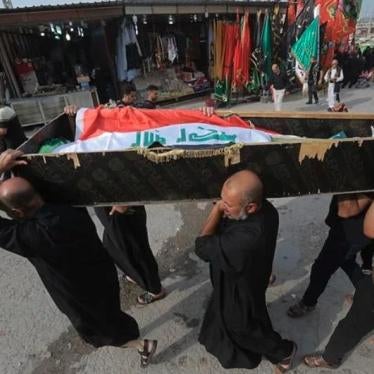(Erbil) – Iraqi security forces fired tear gas canisters into crowds, killing at least eight protesters, during demonstrations in Baghdad on October 25, 2019. Although forces in Baghdad refrained from using live rounds, at demonstrations in southern cities, protesters attempted to burn down Popular Mobilization Forces (Hashad or PMF) office buildings, leading forces inside to open fire and kill protesters. In Basra, a police vehicle drove into a crowd of protesters, injuring some.
“Even facing violent attacks by protesters, security forces are required to limit their response strictly to what is proportionate and necessary to maintain order,” said Sarah Leah Whitson, Middle East director at Human Rights Watch. “What we’ve now seen time and again are Iraqi security forces resorting to unnecessary force, even against nonviolent protesters.”
Protests started in Baghdad and Shia-majority governorates in southern Iraq on October 1, with protesters demanding improved services and more action to curb corruption. Between October 1 and 9, Human Rights Watch documented how security forces used excessive lethal force in confronting rock-throwing protesters, killing 149 and injuring 5,494. Security forces also shot at protesters as they dispersed and sprayed them with scalding water.
Following public outrage at the high death toll, Prime Minister Adil Abd Al-Mahdi on October 22 approved the recommendations of an investigation into the deaths. These included firing senior security officials and investigating senior officials. The investigation found that 70 percent of those killed had died from bullet wounds to the head or chest. It said the authorities should also refer commanders implicated in abuses to the judiciary.
An Interior Ministry spokesman assured the public on October 24 the extreme violence would not be repeated: “The responsibility of the security forces is to secure demonstrations, maintain civil peace, protect citizens' interests and ensure the flow of movement in Baghdad and cities… Everyone is keen on peace and stability and overcoming the mistakes that have taken place in previous demonstrations. We therefore call upon our citizens to practice their normal activities.”
On October 25, protests resumed in Baghdad and southern governorates and are continuing. According to the Independent High Commission for Human Rights of Iraq, 30 protesters were killed and 2,312 were wounded that day, but the death toll mounted to at least 63 by October 26. The Independent High Commission for Human Rights of Iraq said protesters burned and damaged at least 50 government buildings and political party offices across different southern cities. It also said that two journalists were injured. According to NAS News, the Communication and Media Commission ordered a local TV station, Dijlah, off the air because of its protest coverage for the second time this month.
“The government’s misleading assurances that the public wouldn’t again face terrible violence probably encouraged some to believe they would be safe to demonstrate peacefully,” Whitson said.
An international journalist who attended the Baghdad protest on October 25 said he did not see any protesters resorting to violence. He said he saw security forces in black uniforms, who said they were anti-riot police or security forces that protect access to Baghdad’s International Zone (IZ or Green Zone), continuously firing tear gas canisters from 10 a.m. till he left at 4:30 p.m. He said they sometimes fired directly at protesters in a seeming attempt to stop them from breaching the zone. He said that on multiple occasions he saw security forces firing tear gas canisters with such an apparent lack of training that they landed far from the protesters being targeted. Videos on social media posted at about 1 p.m. show a man who was apparently hit in the head and killed with a tear gas canister.
A protester at the Baghdad demonstration told Human Rights Watch that he was a meter away from the protester killed in the video, and saw forces firing canisters at the crowd. “We were just protesting; we didn’t throw anything at the anti-riot police,” he said.
The human rights commission said on October 26 that on October 25 in Baghdad, at least eight of the deaths of protesters resulted from blows from tear gas canister.
The protester and journalist both said that in marked contrast to the early October protests, security forces in Baghdad did not fire live bullets at the crowds on October 25, but instead fired rubber bullets and stun grenades. Media reported five injuries from tear gas canisters to the head in a Baghdad protest on October 26.
Under international human rights standards, law enforcement may only use force when strictly necessary and to the extent required to achieve a legitimate policing objective. Forces should only use tear gas when necessary to prevent further physical harm and where possible issue an advance warning. During violent protests its use must be proportional to the seriousness of the offense, must meet a legitimate law enforcement objective, and should preferably be used alongside other non-lethal methods. The deliberate use of lethal force is only permissible when it is strictly necessary to protect life.
Human Rights Watch reviewed a video shared on WhatsApp, allegedly from a protest in Samawa, 240 kilometers south of Baghdad, which showed protesters throwing rocks towards security forces and the sound of gunfire. Another video, allegedly from Basra, showed a police vehicle driving at high speed into a group of protesters, who attacked the vehicle once it stopped. A protester present on October 25 in Basra said that he saw one anti-riot police vehicle drive at high speed into a crowd of protesters, hitting at least 10, including a boy of around 14 who was sitting on a concrete block in the road. “I saw the car sever his leg. I heard later that he died,” he told Human Rights Watch.
A human rights monitor for a local organization told Human Rights Watch he attended a protest in Amara, 300 kilometers southeast of Baghdad, where at about 3:30 p.m., protesters tried to set fire to the office of the PMF group Asa`ib Ahl al-Haq. He said six men in civilian dress appeared on the roof of the building armed with Kalashnikovs, grenades, and hunting rifles, and opened fire on the protesters trying to approach. “At 4 p.m., I saw them shoot a man in the head in front of the office. He was with a group of about 20 protesters who were trying to enter the building.” He said he saw 10 protesters shot and injured in front of the office and left at 6 p.m. after hearing rumors that more armed forces were coming.
In Nasriya, one protester said he was with a group of about 1,000 people who headed to the office of Asa`ib Ahl al-Haq. As they approached, intending to burn down the office, forces from inside opened fire on them. He said they ran to hide nearby, next to a hospital, and gunfire seemed to also come from there. Protesters told him they saw a sniper on the hospital roof.
“When we got up, we saw bullet marks on the wall above our heads. I also saw a taxi driver who was in the car park of the hospital bringing someone inside get shot in the head, and I saw a doctor inside the hospital later who had been shot and killed,” he told Human Rights Watch. He said he also saw men in an Asa`ib Ahl al-Haq vehicle open fire on a police car.
Iraq’s constitution protects the right to free assembly and peaceful protest. The Iraqi government is obligated under international human rights law to protect the right to free expression and peaceful assembly and its security forces should strictly abide by the UN Basic Principles on the Use of Force and Firearms by Law Enforcement Officials, applying nonviolent means before resorting to the use of force. Authorities should ensure that law enforcement is adequately trained on the use of tear gas and uses it in accordance with the UN principles.
Iraq’s international partners should condemn the use of excessive force, end assistance to units involved in serious violations, and explain publicly the grounds for suspending or ending military assistance.
“It is unacceptable that Iraqi forces are firing tear gas canisters directly at crowds, instead of above them,” Whitson said. “No one should die from a tear gas canister.”









